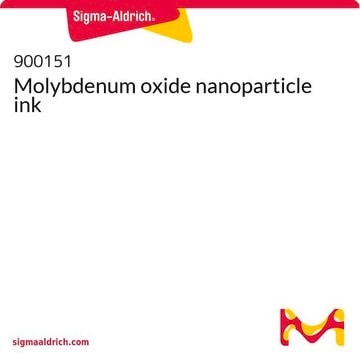577987
Molybdenum
nanopowder, <100 nm particle size (TEM), 99.8% trace metals basis
Synonym(s):
Molybdenum element
Sign Into View Organizational & Contract Pricing
All Photos(1)
About This Item
Empirical Formula (Hill Notation):
Mo
CAS Number:
Molecular Weight:
95.94
EC Number:
MDL number:
UNSPSC Code:
12352302
PubChem Substance ID:
NACRES:
NA.23
Recommended Products
Assay
99.8% trace metals basis
form
nanopowder
resistivity
5.0 μΩ-cm, 20°C
impurities
5% Tungsten
particle size
<100 nm (TEM)
bp
4612 °C (lit.)
mp
2617 °C (lit.)
density
10.3 g/mL at 25 °C (lit.)
SMILES string
[Mo]
InChI
1S/Mo
InChI key
ZOKXTWBITQBERF-UHFFFAOYSA-N
Storage Class Code
13 - Non Combustible Solids
WGK
nwg
Personal Protective Equipment
dust mask type N95 (US), Eyeshields, Gloves
Certificates of Analysis (COA)
Search for Certificates of Analysis (COA) by entering the products Lot/Batch Number. Lot and Batch Numbers can be found on a product’s label following the words ‘Lot’ or ‘Batch’.
Already Own This Product?
Find documentation for the products that you have recently purchased in the Document Library.
Customers Also Viewed
Nuclear nonproliferation. Iranian 'medical' reactor stokes search for alternatives.
Richard Stone
Science (New York, N.Y.), 340(6139), 1392-1392 (2013-06-22)
Measurement of mobility in dual-gated MoS₂ transistors.
Michael S Fuhrer et al.
Nature nanotechnology, 8(3), 146-147 (2013-03-06)
Phillip Ringel et al.
The Journal of biological chemistry, 288(20), 14657-14671 (2013-03-30)
Nitrate reductase (NR) is a complex molybdenum cofactor (Moco)-dependent homodimeric metalloenzyme that is vitally important for autotrophic organism as it catalyzes the first and rate-limiting step of nitrate assimilation. Beside Moco, eukaryotic NR also binds FAD and heme as additional
Alexander O Terent'ev et al.
Organic & biomolecular chemistry, 11(16), 2613-2623 (2013-03-01)
Phosphomolybdic acid (PMA) and phosphotungstic acid (PTA) efficiently catalyze the addition of H2O2 to β-diketones to form bridged 1,2,4,5-tetraoxanes. These reactions are not accompanied by the formation of monocyclic peroxides containing hydroxy and hydroperoxide groups or polymeric peroxides. The use
Stanley S Chou et al.
Journal of the American Chemical Society, 135(12), 4584-4587 (2013-03-12)
MoS2 is a two-dimensional material that is gaining prominence due to its unique electronic and chemical properties. Here, we demonstrate ligand conjugation of chemically exfoliated MoS2 using thiol chemistry. With this method, we modulate the ζ-potential and colloidal stability of
Our team of scientists has experience in all areas of research including Life Science, Material Science, Chemical Synthesis, Chromatography, Analytical and many others.
Contact Technical Service










